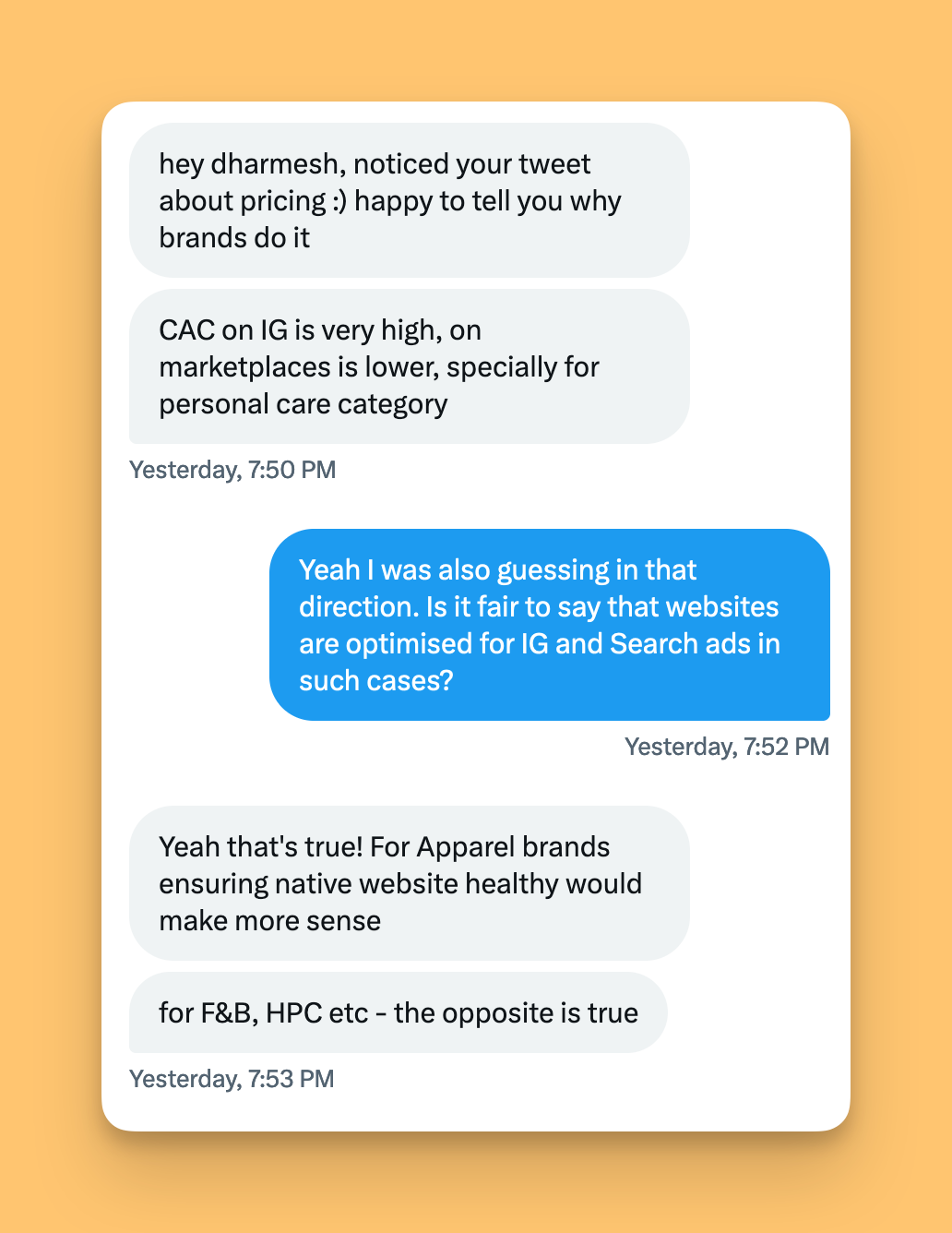Design of ONDC vs Marketplaces
A comparative analysis between the ONDC marketplaces and traditional E-Commerce apps
I recently spent some time at my in-laws' place in Tamil Nadu and observed an interesting behaviour. My mother-in-law insisted that the family buy monthly groceries from her brother's store despite being far from her home. She would call her brother to place the order, and the products would be delivered directly to her doorstep. Two factors play a role here: one is the trust that the shop owner, in this case, her brother, would provide the best quality products for her home, and the second is her indirect support of his livelihood by placing regular monthly orders.
Many of us have experienced a version of this in our lives. Consider the neighbourhood Kirana store or your regular apparel store where you trust the owner to provide quality goods. There's a longing for them to continue to thrive or exist because they make your life simpler.
Table of content
Personal vs Transactional Relationships
A saree shop owner in a small town
Enter ONDC
ONDC vs Marketplaces
Designing for ONDC vs Marketplaces
The D2C curse
Importance of seller on ONDC
Holistic experience vs decoupled experience
Personal vs Transactional Relationships
In our lives, we engage in two kinds of relationships. One is personal relationships, which we share with our friends and family. The other is transactional relationships, which we have with people with whom we might only interact once. This could include delivery executives, carpenters, cab drivers, etc. The relationships we maintain with small businesses on a regular basis fall somewhere in between.
In the online world, we have successfully migrated both personal and transactional relationships to the digital realm. Apps like WhatsApp and Instagram enable us to maintain personal connections, while services like Swiggy, UrbanClap, and OLA facilitate transactional interactions. However, there is no single app that dominates the space that lies between these two extremes.
Small businesses currently achieve this by cobbling together multiple apps, such as Instagram, WhatsApp, and UPI applications.
A saree shop owner in a small town
I recently met my dad's friend, who has been running a saree store for nearly five generations in my hometown, Erode, a small town in Tamil Nadu. He informed me that he has started selling sarees online through Instagram, and now almost 50% of his daily sales occur via the platform.
Here is a detailed tweet thread about how he handles business 🧵
Here are some of the challenges he currently faces
Enter ONDC
India's Open Network for Digital Commerce (ONDC) promises to simplify life for business owners, both online and offline sellers. Here are some of the issues that ONDC aims to address.
ONDC is an initiative by the Indian government to make online shopping fairer and more accessible to everyone. Think of it as a vast digital marketplace where various sellers and buyers can interact directly, without relying on just a few large online platforms.
To draw real-world parallels, Amazon is like a supermarket where you get multiple products and brands under one roof, whereas ONDC strives to build a farmer's market or a bazaar where independent sellers can showcase and sell their products without needing approval from a larger player.
I believe ONDC is well-suited to cater to the creation of semi-personal digital experiences, which small businesses currently attempt to achieve by stringing multiple apps together.
ONDC vs Marketplaces
Take Amazon as an example. It's a one-stop-shop. It onboards sellers, helps them manage inventory, markets their products, and features these products on its shopping app. Finally, it completes the process by delivering these products through its own delivery network.
ONDC, on the other hand, is akin to the director of an orchestra, where each musician plays a different instrument. It allows for the creation of separate, specialized apps: one for sellers to sign up, another for buyers, and yet another for logistics, whether that involves last-mile deliveries or pan-India operations. However, the real magic of ONDC lies in its openness. A seller who joins the network through any app becomes visible across all buyer apps that are built on the ONDC framework. It's like having a small shop that suddenly gets a window display in every nook and corner of the country through ONDC network-linked apps.
It's not just about buying and selling; it's about reimagining the fabric of e-commerce itself.
Designing for ONDC vs Marketplaces
Typically, when we are buying a product online, we reach out to one of the biggest e-commerce players like Amazon, Flipkart, or Meesho and type out our search, or we enter it in Google and then land on their website. A careful observation of the search results will tell us that the results are product-centric and not seller-centric. This means you trust Amazon to curate, and you purchase products from the platform without necessarily knowing the seller or any details about them
.
Even the product pages, which are filled with information about the products, offer little information about the seller, or they hide it behind two clicks.
By design, these marketplaces optimize for repeat purchases from the app, not necessarily from the same seller. Typically, a seller is just one click or one swipe away from losing a customer to someone else. However, in the offline world, once a customer walks into a store, the shop owner puts forth their best efforts to convince the customer to purchase a product, aiming to close a sale. This element is missing in the current marketplace model.
The D2C curse
Does focusing solely on the product benefit Direct-to-Consumer (D2C) brands without an offline presence? Not necessarily. To break free from product-focused marketplaces, D2C brands endeavour to create their own digital spaces through websites and apps. Unfortunately, the amount of money they invest in performance marketing on platforms like Google and Meta can sometimes surpass the commissions they would pay to these marketplaces.
For example, I recently observed that a trimmer from Bombay Shaving Company was priced higher on their own website compared to Amazon. I mentioned this in a tweet, and it garnered some interesting comments.
A D2C founder explained that the Customer Acquisition Cost (CAC) for performance marketing is so high that they are compelled to price their products higher on their own websites. Furthermore, the website prices are typically optimized for the ads being run on Instagram and Google.
Other comments suggested that prices are deliberately kept lower on Amazon to remain competitive with other sellers. This leads to a race to the bottom where no one wins.
Importance of seller on ONDC
On the other hand, ONDC apps present a seller-first approach when searching for a product, where the seller's name is given prominence along with the product.
In the case of a D2C brand, onboarding onto ONDC provides the best of both worlds. Without spending a fortune on performance marketing, they can access a large customer base by going live on multiple buyer apps simultaneously. Since ONDC adopts a brand-first approach, it offers them an opportunity to increase customer affinity towards their brand, as opposed to merely being compared on price and features with other branded products.
Holistic experience vs decoupled experience
For a successful ONDC transaction to occur, there must be a seller/buyer app, a payment partner, and a logistics partner. Typically, the seller and buyer app bring in the payment partner to process the payments. However, logistics can either be managed by the shop itself or by a third-party logistics partner, such as Delhivery or Dunzo.
This aspect is slightly tricky. When you order from Swiggy, Zomato or receive an Amazon-fulfilled product, we never concern ourselves with the delivery agent's identity. What matters most is a seamless, unified experience. However, with ONDC, this becomes an additional step that users must be aware of. Different ONDC apps handle the messaging in various ways
Such decoupling could lead to a blame game if the product is damaged during delivery.
Concrete dispute resolution mechanisms must be established to ensure smoother deliveries and to enhance trust in the network, which is crucial for better user adoption. Ultimately, only time will tell.
(Fin)
This article is co-written by Sidhant Bhutani
Leave a comment below to let us know what you think…
Do you share our views on ONDC? Share this article with your friends and colleagues to know what they think❤️
If you’re new to The India Notes, here are some of our articles you’ll love:




















